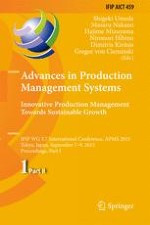The two volumes IFIP AICT 459 and 460 constitute the refereed proceedings of the International IFIP WG 5.7 Conference on Advances in Production Management Systems, APMS 2015, held in Tokyo, Japan, in September 2015. The 163 revised full papers were carefully reviewed and selected from 185 submissions. They are organized in the following topical sections: collaborative networks; globalization and production management; knowledge based production management; project management, engineering management, and quality management; sustainability and production management; co-creating sustainable business processes and ecosystems; open cloud computing architecture for smart manufacturing and cyber physical production systems; the practitioner's view on "innovative production management towards sustainable growth"; the role of additive manufacturing in value chain reconfiguration and sustainability; operations management in engineer-to-order manufacturing; lean production; sustainable system design for green products; cloud-based manufacturing; ontology-aided production - towards open and knowledge-driven planning and control; product-service lifecycle management: knowledge-driven innovation and social implications; and service engineering.
